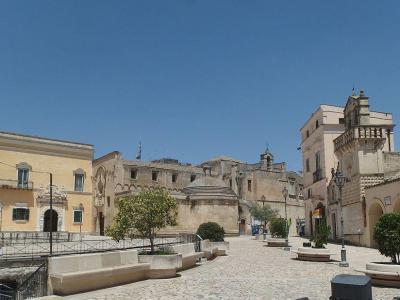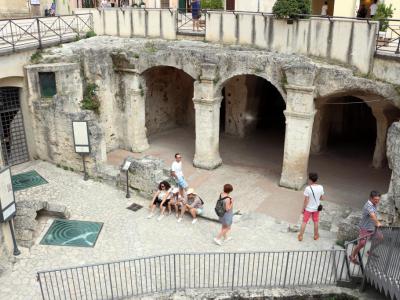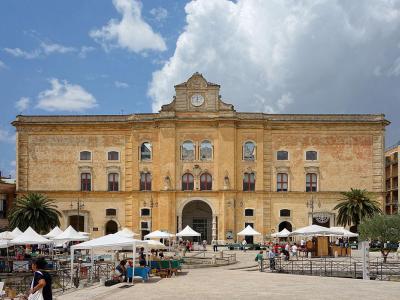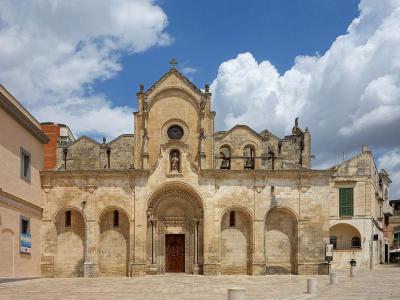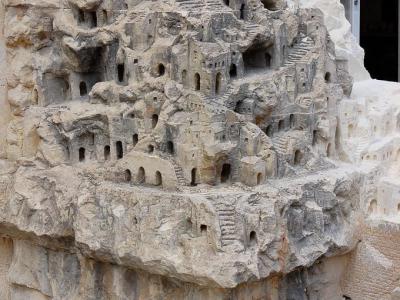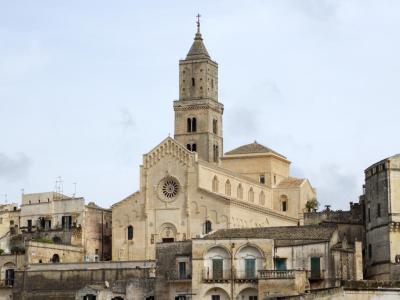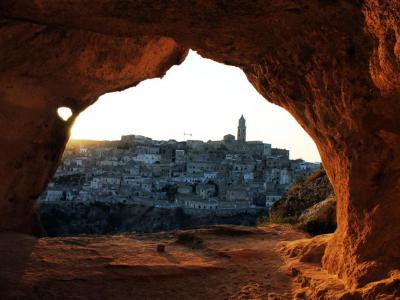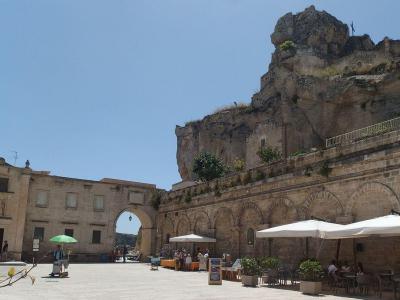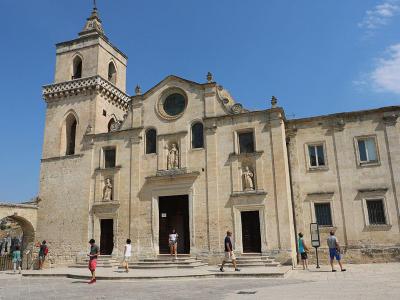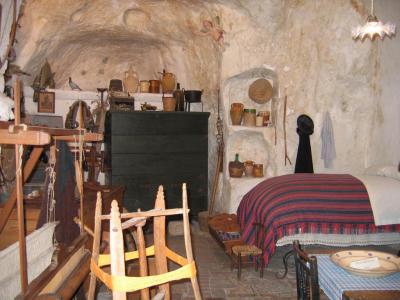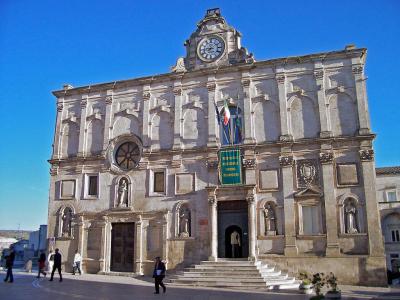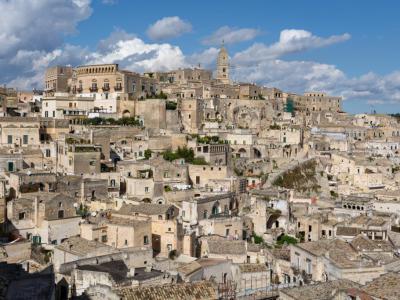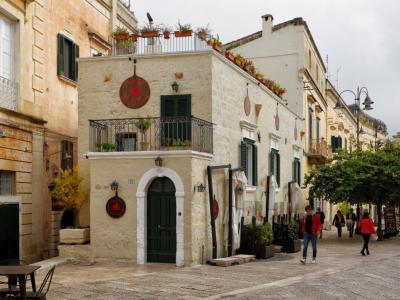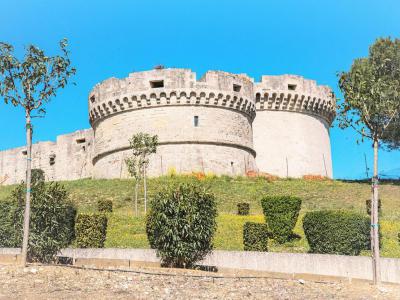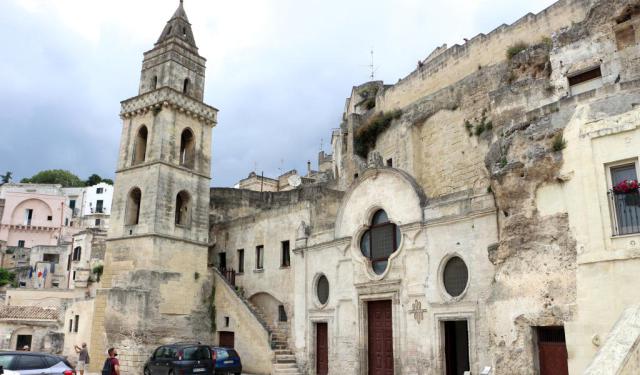Audio Guide: Matera Introduction Walking Tour (Self Guided), Matera
Architectural historian Anne Parmly Toxey said the cave areas of Matera had been occupied for at least 3,000 years. Archaeological research shows people lived here since the Paleolithic era, shaping homes and communal spaces directly into the soft limestone. Over centuries, those modest caves expanded into an intricate neighborhood-stone dwellings, churches, and twisting passageways stacked upon each other. Even its name carries layers: some trace it to the Latin mater, “mother,” evoking the idea of a cradle of settlement, while others suggest meta, “pile,” a reference to the heaped cliffs that define its terrain.
The city entered recorded history in 251 BCE, when Roman consul Lucius Caecilius Metellus founded it as Matheola. The old center developed along the ravines of the Gravina River, where generations continued to live underground in cave dwellings. After Rome’s fall, control shifted like a revolving door-Lombards, Byzantines, Normans-all leaving imprints in fortifications and religious life. By the Middle Ages, Matera’s cathedral, begun in the 13th century, stood at the heart of the city, while the town center remained densely populated with farmers, artisans, and shepherds who often lived side by side with livestock. Life in these cave homes was hard, but not primitive: their layout included a complex system of cisterns and channels for collecting water, proving the sophistication of this “underground city.”
The hardships of the city grew starker in modern times. By the 19th and 20th centuries, overcrowding and poverty plagued the old neighborhood, known as Sassi which means “Stones”. In the 1950s, conditions were deemed so dire that the government forcibly evacuated residents, branding the caves “the shame of Italy.” Entire families were moved into new housing blocks, and the ancient neighborhoods were left abandoned. But time reshaped judgment. Preservationists and scholars recognized the cultural and architectural value of the Sassi, and by the late 20th century restoration was underway. Matera’s revival culminated in 1993, when UNESCO inscribed it as a World Heritage Site.
Walking through Matera today, you’ll trace a path through layers of time. From panoramic views above the ravine to narrow lanes carved from stone, the city unfolds step by step. Highlights along the way include the Sassi in Miniatura, a hand-carved model that condenses centuries of architecture into a single view; the Cave House of Lonely Alley, which preserves a humble dwelling complete with period furnishings; and, hidden beneath Vittorio Veneto Square, the vast Long Diver cistern-dubbed a “water cathedral”-that showcases the ingenuity of past inhabitants. With every turn, Matera reveals its history.
The city entered recorded history in 251 BCE, when Roman consul Lucius Caecilius Metellus founded it as Matheola. The old center developed along the ravines of the Gravina River, where generations continued to live underground in cave dwellings. After Rome’s fall, control shifted like a revolving door-Lombards, Byzantines, Normans-all leaving imprints in fortifications and religious life. By the Middle Ages, Matera’s cathedral, begun in the 13th century, stood at the heart of the city, while the town center remained densely populated with farmers, artisans, and shepherds who often lived side by side with livestock. Life in these cave homes was hard, but not primitive: their layout included a complex system of cisterns and channels for collecting water, proving the sophistication of this “underground city.”
The hardships of the city grew starker in modern times. By the 19th and 20th centuries, overcrowding and poverty plagued the old neighborhood, known as Sassi which means “Stones”. In the 1950s, conditions were deemed so dire that the government forcibly evacuated residents, branding the caves “the shame of Italy.” Entire families were moved into new housing blocks, and the ancient neighborhoods were left abandoned. But time reshaped judgment. Preservationists and scholars recognized the cultural and architectural value of the Sassi, and by the late 20th century restoration was underway. Matera’s revival culminated in 1993, when UNESCO inscribed it as a World Heritage Site.
Walking through Matera today, you’ll trace a path through layers of time. From panoramic views above the ravine to narrow lanes carved from stone, the city unfolds step by step. Highlights along the way include the Sassi in Miniatura, a hand-carved model that condenses centuries of architecture into a single view; the Cave House of Lonely Alley, which preserves a humble dwelling complete with period furnishings; and, hidden beneath Vittorio Veneto Square, the vast Long Diver cistern-dubbed a “water cathedral”-that showcases the ingenuity of past inhabitants. With every turn, Matera reveals its history.
How it works: Download the app "GPSmyCity: Walks in 1K+ Cities" from Apple App Store or Google Play Store to your mobile phone or tablet. The app turns your mobile device into a personal tour guide and its built-in GPS navigation functions guide you from one tour stop to next. The app works offline, so no data plan is needed when traveling abroad.
Matera Introduction Walking Tour Map
Guide Name: Matera Introduction Walking Tour
Guide Location: Italy » Matera (See other walking tours in Matera)
Guide Type: Self-guided Walking Tour (Sightseeing)
# of Attractions: 14
Tour Duration: 2 Hour(s)
Travel Distance: 2.4 Km or 1.5 Miles
Author: DanaOffice
Sight(s) Featured in This Guide:
Guide Location: Italy » Matera (See other walking tours in Matera)
Guide Type: Self-guided Walking Tour (Sightseeing)
# of Attractions: 14
Tour Duration: 2 Hour(s)
Travel Distance: 2.4 Km or 1.5 Miles
Author: DanaOffice
Sight(s) Featured in This Guide:
- Piazza Vittorio Veneto (Vittorio Veneto Square)
- Palombaro Lungo (Palombaro Lungo Cistern)
- Palazzo dell'Annunziata (Annunziata Palace)
- Chiesa di San Giovanni Battista (Church of Saint Giovanni Battista)
- Sassi in Miniatura (Sassi in Miniature)
- Cattedrale di Matera (Matera Cathedral)
- Casa Noha (Noha House)
- Piazza San Pietro Caveoso (San Pietro Caveoso Square)
- Chiesa dei Santi Pietro e Paolo (Saint Peter and Saint Paul Church)
- Casa Grotta di Vico Solitario (Cave House of Lonely Alley)
- Museo di Palazzo Lanfranchi (Lanfranchi Palace Museum)
- Belvedere Piazzetta Pascoli (Pascoli Square Belvedere)
- Via Ridola (Ridola Street)
- Castello Tramontano (Tramontano Castle)
1) Piazza Vittorio Veneto (Vittorio Veneto Square)
Vittorio Veneto Square in Matera has worn several names and carried just as many roles across the centuries. Today it honors the Italian victory over Austria-Hungary in 1918 at Vittorio Veneto, but earlier it was Plebiscite Square, marking the annexation of Rome in 1870, and before that Fontana Square, centered on a fountain restored in 1832 under King Ferdinando II. Every name leaves a trace of political and civic shifts, layered much like the city itself.
By the 18th and 19th centuries, as Matera grew beyond its cave dwellings, the square became the stage for modern life. Neoclassical façades and arcades framed it, while the Annunziata Palace and the Church of Saint Domenico kept watch. The belvedere, with its round arches and terraces, offered a vantage point to the cathedral and the Sassi below, as if the city itself were pausing to admire its past carved into stone.
The most extraordinary story, though, runs beneath the paving stones. In 1832, the Palombaro Lungo was hewed into the rock: an immense underground cistern with stone columns and soaring arches, often called a “water cathedral.” It gathered and stored rainwater, sustaining Matera until the Apulian Aqueduct was completed in the 20th century. What looks like an elegant square above is, in fact, sitting on centuries of ingenious engineering below.
Today the plaza balances daily bustle with historic weight. Markets, cafes, and events fill the open space, while its terraces give clear views into the Sassi, linking Matera’s ancient stone labyrinth with its modern rhythms. Here, civic life and deep history continue to meet in plain sight.
By the 18th and 19th centuries, as Matera grew beyond its cave dwellings, the square became the stage for modern life. Neoclassical façades and arcades framed it, while the Annunziata Palace and the Church of Saint Domenico kept watch. The belvedere, with its round arches and terraces, offered a vantage point to the cathedral and the Sassi below, as if the city itself were pausing to admire its past carved into stone.
The most extraordinary story, though, runs beneath the paving stones. In 1832, the Palombaro Lungo was hewed into the rock: an immense underground cistern with stone columns and soaring arches, often called a “water cathedral.” It gathered and stored rainwater, sustaining Matera until the Apulian Aqueduct was completed in the 20th century. What looks like an elegant square above is, in fact, sitting on centuries of ingenious engineering below.
Today the plaza balances daily bustle with historic weight. Markets, cafes, and events fill the open space, while its terraces give clear views into the Sassi, linking Matera’s ancient stone labyrinth with its modern rhythms. Here, civic life and deep history continue to meet in plain sight.
2) Palombaro Lungo (Palombaro Lungo Cistern) (must see)
Beneath Matera’s Vittorio Veneto Square lies the Palombaro Lungo, a cistern of such scale and ambition that locals began calling it a water cathedral. The project began in the 16th century, when natural caves were stitched together to form part of the city’s water network, though the final push to complete it only came in 1832. By then, the underground chamber stretched long and deep, able to hold nearly five million liters of water collected from rainfall and nearby springs-an immense reservoir for a town where rivers were scarce and every drop mattered. Expansion continued into the 1880s, ensuring that Matera’s residents had a steady supply long before modern pipelines arrived.
The very name tells its story. Some link Palombaro to the Latin for a bird of prey diving toward its target, others to plumbarius, a term for water collectors, while Lungo simply nods to its enormous size. Step inside and the atmosphere justifies the reputation: arches and stone columns rise like the supports of a great basilica, their reflections dancing in the still water below. For generations, this hidden structure fed the square’s fountain above and supplied Matera’s households, until the Apulian Aqueduct, completed in 1920, finally made it redundant.
For decades, the cistern sat sealed and forgotten until 1991, when students climbed in with a dinghy and revealed what lay below. Their discovery, followed by careful restoration, offered the city not just a reclaimed monument but proof of its historic ingenuity-evidence that helped Matera secure its UNESCO World Heritage designation.
Today, raised walkways guide visitors across this immense chamber. With dim lighting, mirrored waters, and soaring vaults, the Palombaro Lungo feels both monumental and intimate-a reminder that Matera’s survival was literally carved out of stone.
The very name tells its story. Some link Palombaro to the Latin for a bird of prey diving toward its target, others to plumbarius, a term for water collectors, while Lungo simply nods to its enormous size. Step inside and the atmosphere justifies the reputation: arches and stone columns rise like the supports of a great basilica, their reflections dancing in the still water below. For generations, this hidden structure fed the square’s fountain above and supplied Matera’s households, until the Apulian Aqueduct, completed in 1920, finally made it redundant.
For decades, the cistern sat sealed and forgotten until 1991, when students climbed in with a dinghy and revealed what lay below. Their discovery, followed by careful restoration, offered the city not just a reclaimed monument but proof of its historic ingenuity-evidence that helped Matera secure its UNESCO World Heritage designation.
Today, raised walkways guide visitors across this immense chamber. With dim lighting, mirrored waters, and soaring vaults, the Palombaro Lungo feels both monumental and intimate-a reminder that Matera’s survival was literally carved out of stone.
3) Palazzo dell'Annunziata (Annunziata Palace)
Picture yourself on Vittorio Veneto Square, where the Annunziata Palace looms in stone, carrying with it three centuries of change. Work began in 1739 under Valentino da Bitonto, who planned a standard Dominican convent with the church at its heart. But he was dismissed only a few years later, and in 1742 Manieri da Lecce took over, tearing up the scheme and swapping the central church for a courtyard. The result still hints at its monastic origin, but with a far more open and civic character.
By the mid-19th century, the building shifted again. Engineer Gaetano di Giorgio added a new Annunciation Church in 1844, finally giving the Dominican nuns their sanctuary. Their tenure, however, was short-lived-when religious orders were suppressed in 1861, the convent became civic property. Over the following decades, its halls echoed with courtrooms, classrooms, and offices, adapting steadily as Matera itself moved from cloistered stronghold to provincial capital.
Time left its marks. In 1900 a clock was placed on the exterior, symbolizing its civic role, while the earthquake of 1980 nearly emptied the building altogether. Restoration in 1998 revived the palace and brought in the Provincial Library “Tommaso Stigliani”, which now shelters thousands of manuscripts, rare volumes, and even a significant coin collection-transforming a once-religious space into a repository of knowledge.
Architecturally, the palace carries both late Baroque and early Neoclassical traits, its arcades and balanced façade anchoring the square alongside the Church of Saint Domenico. From its steps, the view sweeps across Vittorio Veneto and into the Sassi, reminding you how Matera’s past has been written equally in cloisters, classrooms, and libraries.
By the mid-19th century, the building shifted again. Engineer Gaetano di Giorgio added a new Annunciation Church in 1844, finally giving the Dominican nuns their sanctuary. Their tenure, however, was short-lived-when religious orders were suppressed in 1861, the convent became civic property. Over the following decades, its halls echoed with courtrooms, classrooms, and offices, adapting steadily as Matera itself moved from cloistered stronghold to provincial capital.
Time left its marks. In 1900 a clock was placed on the exterior, symbolizing its civic role, while the earthquake of 1980 nearly emptied the building altogether. Restoration in 1998 revived the palace and brought in the Provincial Library “Tommaso Stigliani”, which now shelters thousands of manuscripts, rare volumes, and even a significant coin collection-transforming a once-religious space into a repository of knowledge.
Architecturally, the palace carries both late Baroque and early Neoclassical traits, its arcades and balanced façade anchoring the square alongside the Church of Saint Domenico. From its steps, the view sweeps across Vittorio Veneto and into the Sassi, reminding you how Matera’s past has been written equally in cloisters, classrooms, and libraries.
4) Chiesa di San Giovanni Battista (Church of Saint Giovanni Battista)
The Church of Saint Giovanni Battista is one of Matera’s most distinctive medieval survivors, its story reaching back to the early 13th century. In 1215, nuns of the Order of Saint Mary of Acre arrived from the Middle East and took over a modest chapel called Saint Maria la Nova. Soon after, in 1229, they began building something larger, completed in 1236. First dedicated to the Our Lady of Virtues, it later passed to the Benedictine nuns and took on its current title, honoring Saint John the Baptist.
Its location, just beyond Matera’s walls, proved risky. When the Ottomans advanced into southern Italy in 1480, the nuns abandoned it rather than risk exposure outside the fortifications. The church sat unused for over two centuries until 1695, when the archbishop reassigned the parish here. Later centuries added layers of change-an 18th-century sacristy, a Chapel of the Blessed Sacrament, and modifications that reshaped the transept domes into vaults.
Architecturally, Saint Giovanni Battista straddles Romanesque and Gothic. The Latin cross plan brings a nave with unusual Lecce vaults, three apses framed by sculpted arches, and side chapels that soften its austere form. The façade, simple yet commanding, is marked by a rose window and a statue of John the Baptist above the entrance. Inside, carved capitals decorated with plants and symbolic figures showcase the craft of 13th-century stonemasons. Frescoes of Saint Maria la Nova and sculptures anchor its artistic legacy.
A rare free-standing medieval church in a city famed for rock-hewed sanctuaries, Saint Giovanni Battista remains a reminder of Matera’s shifting fortunes-abandonment, renewal, and enduring presence.
Its location, just beyond Matera’s walls, proved risky. When the Ottomans advanced into southern Italy in 1480, the nuns abandoned it rather than risk exposure outside the fortifications. The church sat unused for over two centuries until 1695, when the archbishop reassigned the parish here. Later centuries added layers of change-an 18th-century sacristy, a Chapel of the Blessed Sacrament, and modifications that reshaped the transept domes into vaults.
Architecturally, Saint Giovanni Battista straddles Romanesque and Gothic. The Latin cross plan brings a nave with unusual Lecce vaults, three apses framed by sculpted arches, and side chapels that soften its austere form. The façade, simple yet commanding, is marked by a rose window and a statue of John the Baptist above the entrance. Inside, carved capitals decorated with plants and symbolic figures showcase the craft of 13th-century stonemasons. Frescoes of Saint Maria la Nova and sculptures anchor its artistic legacy.
A rare free-standing medieval church in a city famed for rock-hewed sanctuaries, Saint Giovanni Battista remains a reminder of Matera’s shifting fortunes-abandonment, renewal, and enduring presence.
5) Sassi in Miniatura (Sassi in Miniature)
The Sassi in Miniatura in Matera feels like a city within a city-only this one fits inside a single room. On Fiorentini Street in the Sasso Barisano, not far from the Cathedral and Tramontano Castle, artisan Eustachio Rizzi set himself a challenge back in 1996: to carve Matera’s entire cave district into the very stone it was built from. Three years later, out came a 129-square-foot model, weighing 3,500 pounds, and packed with enough detail to make your eyes linger for minutes on a single corner.
Look closely, and the city shrinks before you: staircases zigzagging up hillsides, courtyards tucked between homes, mule paths winding their way past farmhouses, and even little churches glowing with lights. The sheer density of the real Sassi can overwhelm first-time visitors, but Rizzi’s miniature distills centuries of growth into one comprehensible view-a kind of stone-made map that shows how people, animals, and faith all shared the same carved landscape.
The workshop doubles as a gallery of smaller stone carvings and souvenirs, tying Matera’s geology to its cultural identity. But the big model is more than just orientation-it’s commentary. The Sassi, once abandoned and condemned as the “shame of Italy,” now stand as a UNESCO World Heritage Site, and Rizzi’s creation mirrors that turnaround. By chiseling the story of Matera into miniature, he gave visitors a way to understand not only the city’s structure but also its resilience.
Walking through the real Sassi after seeing the model feels different. You already carry in your head a compressed version of the maze, which makes each alley and staircase less confusing and more alive-like you’ve already walked the city once before, only in miniature.
Look closely, and the city shrinks before you: staircases zigzagging up hillsides, courtyards tucked between homes, mule paths winding their way past farmhouses, and even little churches glowing with lights. The sheer density of the real Sassi can overwhelm first-time visitors, but Rizzi’s miniature distills centuries of growth into one comprehensible view-a kind of stone-made map that shows how people, animals, and faith all shared the same carved landscape.
The workshop doubles as a gallery of smaller stone carvings and souvenirs, tying Matera’s geology to its cultural identity. But the big model is more than just orientation-it’s commentary. The Sassi, once abandoned and condemned as the “shame of Italy,” now stand as a UNESCO World Heritage Site, and Rizzi’s creation mirrors that turnaround. By chiseling the story of Matera into miniature, he gave visitors a way to understand not only the city’s structure but also its resilience.
Walking through the real Sassi after seeing the model feels different. You already carry in your head a compressed version of the maze, which makes each alley and staircase less confusing and more alive-like you’ve already walked the city once before, only in miniature.
6) Cattedrale di Matera (Matera Cathedral) (must see)
The Matera Cathedral crowns the city from the highest ridge between the Sassi districts, a position that has made it both a landmark and a watchful presence for nearly eight centuries. Work began around 1230, on the ruins of a Benedictine monastery, and by 1270 the new cathedral was ready-first dedicated to Saint Eustace, then later to the Dark-skinned Madonna, who became Matera’s most beloved protector. From the outside, the building still carries the clean lines of the 13th century, while the interior reveals a far more layered history of alteration and embellishment.
Look closely at the façade: a rose window with sixteen rays bursts out from the stone, framed above by Archangel Michael trampling a dragon. Below, an Atlas figure strains under the weight of the design, while a row of lemons-twelve in all-quietly symbolize the apostles. Lions, saints, and prophets guard the portal, while a 170-foot bell tower rises beside it, visible from every corner of the Sassi.
Step inside and the mood shifts. A Byzantine fresco of the Dark-skinned Madonna survives from the 13th century, while later centuries gilded the space with painted ceilings, elaborate plasterwork, and golden altars. The wooden choir stalls, Persio’s Nativity, and Santoro’s paintings all speak to Matera’s artistic lineage. The Chapel of the Annunciation, with its coffered ceiling and sculpted Virgin, completes the ensemble.
Neglect, earthquakes, and restorations have all left their trace, but since reopening in 2016 the cathedral has returned to its role as both parish church and symbol of civic pride. From its terrace, the view sweeps down over the Sassi, making the cathedral as much a vantage point on Matera’s history as it is a place of worship.
Look closely at the façade: a rose window with sixteen rays bursts out from the stone, framed above by Archangel Michael trampling a dragon. Below, an Atlas figure strains under the weight of the design, while a row of lemons-twelve in all-quietly symbolize the apostles. Lions, saints, and prophets guard the portal, while a 170-foot bell tower rises beside it, visible from every corner of the Sassi.
Step inside and the mood shifts. A Byzantine fresco of the Dark-skinned Madonna survives from the 13th century, while later centuries gilded the space with painted ceilings, elaborate plasterwork, and golden altars. The wooden choir stalls, Persio’s Nativity, and Santoro’s paintings all speak to Matera’s artistic lineage. The Chapel of the Annunciation, with its coffered ceiling and sculpted Virgin, completes the ensemble.
Neglect, earthquakes, and restorations have all left their trace, but since reopening in 2016 the cathedral has returned to its role as both parish church and symbol of civic pride. From its terrace, the view sweeps down over the Sassi, making the cathedral as much a vantage point on Matera’s history as it is a place of worship.
7) Casa Noha (Noha House) (must see)
Noha House doesn’t just stand quietly in Matera’s Civita district-it speaks. Built in the 15th century as the residence of the noble Noha family, it once anchored a patchwork of gardens and estates that even included their own bridge, linking their property to the Saint Paolo quarter. Unlike their peers, who chose more stable terrain, the Nohas built their home directly over an erosion channel. To shore it up, they recycled ruins as foundations, unintentionally unearthing traces of Bronze and Iron Age life, along with Greek, Roman, and medieval layers. In short, Noha House was perched above a cross-section of Matera’s entire past.
Architecturally, it mirrors the Sassi themselves-half-carved into the rock, half-built above ground. A courtyard framed by service rooms, an external staircase climbing toward the living quarters, and stone details give the house its distinctive form. For centuries it remained a private residence, until it was donated to the Italian Environmental Fund, an organization dedicated to preserving Italy’s heritage. Acquired in 2004, it was carefully restored and transformed from a family home into a cultural threshold for the city.
Step inside and you won’t find display cases or shelves of artifacts. Instead, the house itself becomes the stage for The Invisible Stones, a thirty-minute immersive presentation. Film, archival images, and narration flood the walls, guiding visitors through Matera’s story-from its earliest cave settlements to its medieval faith, from the abandonment and stigma of the 20th century to the UNESCO recognition and cultural revival that redefined its future.
Noha House now acts as both a preserved piece of Matera’s fabric and a lens through which the city is understood. By sitting in its cool stone rooms, visitors gain not only orientation but perspective: the journey of a city once dismissed as a national embarrassment, reborn as a European Capital of Culture, carved permanently into the rock of memory.
Architecturally, it mirrors the Sassi themselves-half-carved into the rock, half-built above ground. A courtyard framed by service rooms, an external staircase climbing toward the living quarters, and stone details give the house its distinctive form. For centuries it remained a private residence, until it was donated to the Italian Environmental Fund, an organization dedicated to preserving Italy’s heritage. Acquired in 2004, it was carefully restored and transformed from a family home into a cultural threshold for the city.
Step inside and you won’t find display cases or shelves of artifacts. Instead, the house itself becomes the stage for The Invisible Stones, a thirty-minute immersive presentation. Film, archival images, and narration flood the walls, guiding visitors through Matera’s story-from its earliest cave settlements to its medieval faith, from the abandonment and stigma of the 20th century to the UNESCO recognition and cultural revival that redefined its future.
Noha House now acts as both a preserved piece of Matera’s fabric and a lens through which the city is understood. By sitting in its cool stone rooms, visitors gain not only orientation but perspective: the journey of a city once dismissed as a national embarrassment, reborn as a European Capital of Culture, carved permanently into the rock of memory.
8) Piazza San Pietro Caveoso (San Pietro Caveoso Square)
Saint Pietro Caveoso Square feels like a stage set where Matera’s history and landscape perform together. The square takes its name from the Church of Saints Peter and Paul, built in the 13th century and later dressed up with a Baroque outside and towers. From its perch on the cliff edge, the church commands attention, with the gorge of the Gravina river and the rocky plateau of the Murgia rolling away behind it. The result is a setting where stone, faith, and landscape intertwine.
For centuries, this square carried the rhythm of local life. Religious processions wound their way through it, markets filled the open space, and families from the cave dwellings of Sasso Caveoso mixed with those crossing in from the plateau. The surrounding rock-carved homes and palaces form a kind of natural amphitheater, pressing close around the plaza while opening dramatically toward the ravine. Walk a little further and paths lead into lamias-plain cave houses once shared by farmers, animals, and tools. These were the same dwellings branded as the “shame of Italy” in the 20th century, abandoned in poverty but still haunting in their raw authenticity.
Today, the square serves as both a gathering point and a vantage point. From here you can step toward rock churches like the Madonna of Idris or Saint Lucia alle Malve, or simply pause to take in the layered view of Matera’s past carved into stone. By day, the square is a hub for visitors; by night, the unlit alleys beyond make it better left to guided walks. Saint Pietro Caveoso Square remains a place where Matera’s contrasts-sacred and domestic, ruin and revival-are laid bare in one unforgettable panorama.
For centuries, this square carried the rhythm of local life. Religious processions wound their way through it, markets filled the open space, and families from the cave dwellings of Sasso Caveoso mixed with those crossing in from the plateau. The surrounding rock-carved homes and palaces form a kind of natural amphitheater, pressing close around the plaza while opening dramatically toward the ravine. Walk a little further and paths lead into lamias-plain cave houses once shared by farmers, animals, and tools. These were the same dwellings branded as the “shame of Italy” in the 20th century, abandoned in poverty but still haunting in their raw authenticity.
Today, the square serves as both a gathering point and a vantage point. From here you can step toward rock churches like the Madonna of Idris or Saint Lucia alle Malve, or simply pause to take in the layered view of Matera’s past carved into stone. By day, the square is a hub for visitors; by night, the unlit alleys beyond make it better left to guided walks. Saint Pietro Caveoso Square remains a place where Matera’s contrasts-sacred and domestic, ruin and revival-are laid bare in one unforgettable panorama.
9) Chiesa dei Santi Pietro e Paolo (Saint Peter and Saint Paul Church)
Saint Pietro Caveoso isn’t shy about making an entrance. Balanced at the edge of the Gravina ravine, this 13th-century church began as a medieval outpost of devotion for the Sasso Caveoso quarter, only to be refashioned in the 17th and 18th centuries with a Baroque façade and twin towers that gave it a more stage presence. Those layers remain visible: a medieval skeleton dressed up with later ornament, reflecting how Matera itself has always balanced tradition with reinvention.
The front of the church is a stone storybook. Three portals are topped with statues-Our Lady of Mercy in the center, Peter and Paul flanking her-while a rose window of sixteen rays spins above, its details held up by crouching lions and framed with saints. To one side, the 170-foot bell tower, all Gothic arches and a tiered spire, punctuates the skyline like a watchtower over the ravine.
Step inside and the tone changes. The plan follows a Latin cross with three naves divided by arcades, but what fills that space is a conversation between eras. There’s the sobriety of a 13th-century baptismal font, the flourish of an 18th-century altar with a painted altarpiece, frescoes tracing biblical stories, and wooden choir stalls worn smooth by centuries of use. Ceiling paintings by local artists and chapels dressed with carved stone keep the rhythm shifting between restraint and exuberance.
Then there’s the setting. Standing on its steps, you’re suspended between the church and the landscape, looking out over the Gravina gorge to the Murgia plateau, where rock-cut chapels dot the cliffs. It’s part sanctuary, part lookout, and entirely a reminder of how Matera’s faith and terrain have always been entwined.
The front of the church is a stone storybook. Three portals are topped with statues-Our Lady of Mercy in the center, Peter and Paul flanking her-while a rose window of sixteen rays spins above, its details held up by crouching lions and framed with saints. To one side, the 170-foot bell tower, all Gothic arches and a tiered spire, punctuates the skyline like a watchtower over the ravine.
Step inside and the tone changes. The plan follows a Latin cross with three naves divided by arcades, but what fills that space is a conversation between eras. There’s the sobriety of a 13th-century baptismal font, the flourish of an 18th-century altar with a painted altarpiece, frescoes tracing biblical stories, and wooden choir stalls worn smooth by centuries of use. Ceiling paintings by local artists and chapels dressed with carved stone keep the rhythm shifting between restraint and exuberance.
Then there’s the setting. Standing on its steps, you’re suspended between the church and the landscape, looking out over the Gravina gorge to the Murgia plateau, where rock-cut chapels dot the cliffs. It’s part sanctuary, part lookout, and entirely a reminder of how Matera’s faith and terrain have always been entwined.
10) Casa Grotta di Vico Solitario (Cave House of Lonely Alley) (must see)
The Cave House of Lonely Alley pulls you straight into Matera’s past, before 1952, when the government declared the Sassi unfit for living and moved families out. While many of the old cave homes have since been polished into hotels and guesthouses, this one was left as it was-complete with tools, furniture, and the everyday traces of life carved into stone. It’s less a reconstruction than a freeze-frame, showing exactly how generations managed to live inside the rock.
The house itself is set in a natural hollow in the limestone, with additions made over the 18th century. Step through its wide archway and you enter a single chamber, where spaces were divided not by walls but by necessity. Light fell on the front rooms, so that’s where cooking, eating, and sleeping took place. A single table fed the family, a brazier provided heat, and a raised bed with a corn-stuffed mattress kept dampness at bay.
Move further in and the cave becomes more practical: a manger for the mule, a manure pit, and rough stables. Tools, pottery, and a loom remind us that work and domestic life were inseparable, while channels cut into the rock fed a cistern that captured every drop of precious rainwater.
When the Sassi were abandoned, the house-like many others-stood empty, part of what Italians called the “shame of Italy.” Today, it survives as a reminder of that era, complemented by nearby sites like the rock church of Saint Pietro Monterrone and a snow cave now showing old documentary footage.
The Cave House of Lonely Alley doesn’t romanticize the past-it lets you walk into it, stone walls and all, and see how people endured by turning bare rock into a home.
The house itself is set in a natural hollow in the limestone, with additions made over the 18th century. Step through its wide archway and you enter a single chamber, where spaces were divided not by walls but by necessity. Light fell on the front rooms, so that’s where cooking, eating, and sleeping took place. A single table fed the family, a brazier provided heat, and a raised bed with a corn-stuffed mattress kept dampness at bay.
Move further in and the cave becomes more practical: a manger for the mule, a manure pit, and rough stables. Tools, pottery, and a loom remind us that work and domestic life were inseparable, while channels cut into the rock fed a cistern that captured every drop of precious rainwater.
When the Sassi were abandoned, the house-like many others-stood empty, part of what Italians called the “shame of Italy.” Today, it survives as a reminder of that era, complemented by nearby sites like the rock church of Saint Pietro Monterrone and a snow cave now showing old documentary footage.
The Cave House of Lonely Alley doesn’t romanticize the past-it lets you walk into it, stone walls and all, and see how people endured by turning bare rock into a home.
11) Museo di Palazzo Lanfranchi (Lanfranchi Palace Museum)
Lanfranchi Palace brings a touch of grandeur to Giovanni Pascoli Square, its baroque façade standing as proof that 17th-century Matera knew how to make an impression. Commissioned by Bishop Vincenzo Lanfranchi between 1668 and 1672, the building began life as a seminary, built in line with the vision of strengthening Catholic presence. Though designed with function in mind, the palace never lost its flair, absorbing older structures into a monumental front that still commands attention today.
The palace’s story doesn’t end with the clergy. By the 19th century, the seminary’s days were over, and new roles followed. It was tied to the Church of the Carmine, adapted for judicial use, and even served educational purposes before settling into civic life. The real transformation came in the late 20th century, when restoration prepared it for its present role. Since 2003, Lanfranchi Palace has been home to the National Museum of Medieval and Modern Art of Basilicata, breathing new life into its historic halls.
Inside, the collections move across centuries. Sacred Art preserves pieces rescued from regional churches, while the Collectibles section displays canvases from the Neapolitan school of the 17th and 18th centuries. The modern galleries highlight works by Luigi Guerricchio and Carlo Levi, whose exile in Basilicata inspired Christ Stopped at Eboli. Levi’s paintings-showing the hardships and resilience of southern peasants-anchor the building’s cultural narrative in the 20th century.
And of course, the palace itself plays its part. Visitors move through arcaded halls, cloisters, and staircases, with occasional views opening over the Sasso Caveoso below. Today, exhibitions, conferences, and cultural events fill the rooms, keeping the palace both a historic monument and a working cultural hub. It is less a relic than a bridge: between baroque Matera, modern Basilicata, and the stories that bind them together.
The palace’s story doesn’t end with the clergy. By the 19th century, the seminary’s days were over, and new roles followed. It was tied to the Church of the Carmine, adapted for judicial use, and even served educational purposes before settling into civic life. The real transformation came in the late 20th century, when restoration prepared it for its present role. Since 2003, Lanfranchi Palace has been home to the National Museum of Medieval and Modern Art of Basilicata, breathing new life into its historic halls.
Inside, the collections move across centuries. Sacred Art preserves pieces rescued from regional churches, while the Collectibles section displays canvases from the Neapolitan school of the 17th and 18th centuries. The modern galleries highlight works by Luigi Guerricchio and Carlo Levi, whose exile in Basilicata inspired Christ Stopped at Eboli. Levi’s paintings-showing the hardships and resilience of southern peasants-anchor the building’s cultural narrative in the 20th century.
And of course, the palace itself plays its part. Visitors move through arcaded halls, cloisters, and staircases, with occasional views opening over the Sasso Caveoso below. Today, exhibitions, conferences, and cultural events fill the rooms, keeping the palace both a historic monument and a working cultural hub. It is less a relic than a bridge: between baroque Matera, modern Basilicata, and the stories that bind them together.
12) Belvedere Piazzetta Pascoli (Pascoli Square Belvedere)
Pascoli Square Belvedere may be small in size, but it has long punched above its weight in Matera’s story. Tucked beside the 17th-century Lanfranchi Palace-once a Dominican seminary, now home to the National Museum of Medieval and Modern Art of Basilicata-it carries the name of poet Giovanni Pascoli, who briefly taught here in the 19th century. For a man of words, this outlook would have needed none: the view alone speaks volumes.
From the parapet, the Sassi districts stretch out in layers-Sasso Caveoso and Sasso Barisano clinging to the limestone cliffs, with the Gravina gorge plunging below and the Murgia plateau beyond. The cathedral rises on the ridge, rupestrian churches mark the cliffs, and at night the caves glitter with light, as if Matera itself were a constellation set into stone.
The square has also doubled as a stage for art and reflection. In 2011, Japanese sculptor Kengiro Azuma placed The Drop here, a bronze monument nearly three meters tall, a reminder that water has always been the lifeblood of the city carved into rock. Long before that, in the 17th and 18th centuries, this terrace was part of Matera’s baroque expansion, linking the civic quarter with the ancient cave districts below. By the 20th century, it had settled into the role of gathering ground, alive with markets, concerts, and public life.
Today, Pascoli Plaza balances past and present. It frames one of Matera’s most photographed panoramas while remaining a lived-in square, where everyday chatter mixes with centuries of history beneath the open sky.
From the parapet, the Sassi districts stretch out in layers-Sasso Caveoso and Sasso Barisano clinging to the limestone cliffs, with the Gravina gorge plunging below and the Murgia plateau beyond. The cathedral rises on the ridge, rupestrian churches mark the cliffs, and at night the caves glitter with light, as if Matera itself were a constellation set into stone.
The square has also doubled as a stage for art and reflection. In 2011, Japanese sculptor Kengiro Azuma placed The Drop here, a bronze monument nearly three meters tall, a reminder that water has always been the lifeblood of the city carved into rock. Long before that, in the 17th and 18th centuries, this terrace was part of Matera’s baroque expansion, linking the civic quarter with the ancient cave districts below. By the 20th century, it had settled into the role of gathering ground, alive with markets, concerts, and public life.
Today, Pascoli Plaza balances past and present. It frames one of Matera’s most photographed panoramas while remaining a lived-in square, where everyday chatter mixes with centuries of history beneath the open sky.
13) Via Ridola (Ridola Street)
Ridola street might only run a couple of hundred meters through Matera, but it carries the weight of centuries. It’s named after Domenico Ridola, the physician-turned-amateur archaeologist who dug into local caves and revealed just how far back Matera’s story stretches. He was also mayor, senator, and the kind of citizen who leaves a permanent mark-his finds became the foundation of the Archaeological Museum that now bears his name. The museum, housed in the former Saint Chiara Convent, still displays everything from Neolithic tools to Greek relics, alongside Ridola’s own manuscripts.
The street itself took shape during the baroque makeover of Matera in the 17th and 18th centuries. Archbishop Antonio Del Ryos ordered a new district beyond the crowded Sassi, calling it the “New Houses,” and Ridola Street became its backbone. Palaces and churches rose along its edges, setting the stage for a new civic quarter that contrasted with the ancient caves below. Walking today, you’ll pass the façade of the Church of Purgatorio, with skulls carved into its stonework, and the Church of San Francesco, a baroque flourish in an otherwise austere landscape. Lanfranchi Palace, built as a seminary in 1672, now serves as the National Museum of Medieval and Modern Art of Basilicata, housing sacred art, Neapolitan canvases, and works by Carlo Levi, the artist and writer who turned Matera into a symbol of resilience.
The walk ends at Pascoli Belvedere Square, where the land suddenly opens up to reveal the cathedral on the ridge, the Sassi spilling into the Gravina gorge, and the plateau beyond. Ridola street, in that sense, is more than a street-it’s Matera’s timeline, condensed into one elegant stroll.
The street itself took shape during the baroque makeover of Matera in the 17th and 18th centuries. Archbishop Antonio Del Ryos ordered a new district beyond the crowded Sassi, calling it the “New Houses,” and Ridola Street became its backbone. Palaces and churches rose along its edges, setting the stage for a new civic quarter that contrasted with the ancient caves below. Walking today, you’ll pass the façade of the Church of Purgatorio, with skulls carved into its stonework, and the Church of San Francesco, a baroque flourish in an otherwise austere landscape. Lanfranchi Palace, built as a seminary in 1672, now serves as the National Museum of Medieval and Modern Art of Basilicata, housing sacred art, Neapolitan canvases, and works by Carlo Levi, the artist and writer who turned Matera into a symbol of resilience.
The walk ends at Pascoli Belvedere Square, where the land suddenly opens up to reveal the cathedral on the ridge, the Sassi spilling into the Gravina gorge, and the plateau beyond. Ridola street, in that sense, is more than a street-it’s Matera’s timeline, condensed into one elegant stroll.
14) Castello Tramontano (Tramontano Castle)
Tramontano Castle looms over Matera as both a fortress and a cautionary tale. Its story begins in 1506, when Count Giovanni Carlo Tramontano managed to hold onto his title by playing court politics-his wife offered the queen of Naples a necklace so extravagant it could have paid for a city. With his position secure, the count turned to his next project: a grand castle on Lapillo Hill. The funds? Raised through crushing taxes, which only added to his reputation for arrogance and abuse of feudal rights. By 1514, the resentment boiled over. As Tramontano left mass at the cathedral, townspeople struck. They stripped him, beat him, and killed him on the spot. The bells tolled, the building works halted, and the castle was left unfinished forever.
What remains is a fortress in the Aragonese style: a central keep flanked by round towers with crenelated tops, arrow slits, and heavy limestone walls. Even half-complete, the structure still conveys the authority it was meant to project, a hulking presence that dominates the skyline while reminding locals of the revolt that cut its story short.
Centuries later, the castle received a gentler fate. In 2008, restoration began to stabilize the walls and revive the moat and park, financed, fittingly enough, by lottery funds. Today, Tramontano Castle is more of an outdoor stage than a furnished stronghold, a place where festivals light up its towers at night and where visitors can walk the perimeter for sweeping views of Matera and the countryside. A monument to ambition, revolt, and resilience-all in stone.
What remains is a fortress in the Aragonese style: a central keep flanked by round towers with crenelated tops, arrow slits, and heavy limestone walls. Even half-complete, the structure still conveys the authority it was meant to project, a hulking presence that dominates the skyline while reminding locals of the revolt that cut its story short.
Centuries later, the castle received a gentler fate. In 2008, restoration began to stabilize the walls and revive the moat and park, financed, fittingly enough, by lottery funds. Today, Tramontano Castle is more of an outdoor stage than a furnished stronghold, a place where festivals light up its towers at night and where visitors can walk the perimeter for sweeping views of Matera and the countryside. A monument to ambition, revolt, and resilience-all in stone.
Walking Tours in Matera, Italy
Create Your Own Walk in Matera
Creating your own self-guided walk in Matera is easy and fun. Choose the city attractions that you want to see and a walk route map will be created just for you. You can even set your hotel as the start point of the walk.
Matera's Ancient Cave Churches
Within the old city of Matera, there are more than 160 churches. Many of these are actually carved into the soft limestone cliffs lining the Gravina River. There are even some used for pagan rituals. The churches were carved from existing caves and tunnels. More than a few sanctified cave churches have been converted to storage and homes.
A good example to start with is the St. Anthony... view more
Tour Duration: 1 Hour(s)
Travel Distance: 1.7 Km or 1.1 Miles
A good example to start with is the St. Anthony... view more
Tour Duration: 1 Hour(s)
Travel Distance: 1.7 Km or 1.1 Miles
The Most Popular Cities
/ view all



